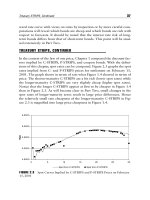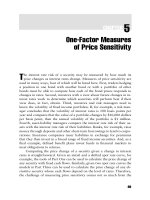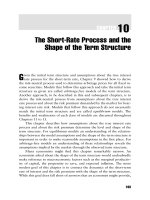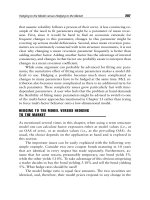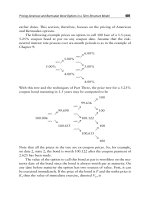Economic issues today alternative approaches, eighth edition
Bạn đang xem bản rút gọn của tài liệu. Xem và tải ngay bản đầy đủ của tài liệu tại đây (17.14 MB, 422 trang )
Economic
Issues Today
This page intentionally left blank
Economic
Issues Today
Alternative Approaches
Eighth Ed ition
Robert B. Carson, Wade L. Thomas, Jason Hecht
I~ ~~o~;!~n~~~up
LONDON AND NEW YORK
First published 2005 by M.E. Sharpe
Published 2015 by Routledge
2 Park Square, Milton Park, Abingdon, Oxon OX14 4RN
711 Third Avenue, New York, NY, 10017, USA
Routledge is an imprint of the Taylor & Francis Group, an informa business
Copyright © 2005, Taylor & Francis. All rights reserved.
No part of this book may be reprinted or reproduced or utilised in any form or by
any electronic, mechanical, or other means, now known or hereafter invented,
including photocopying and recording, or in any information storage or retrieval
system, without permission in writing from the publishers.
Notices
No responsibility is assumed by the publisher for any injury and/or damage to
persons or property as a matter of products liability, negligence or otherwise,
or from any use of operation of any methods, products, instructions or ideas
contained in the material herein.
Practitioners and researchers must always rely on their own experience and
knowledge in evaluating and using any information, methods, compounds, or
experiments described herein. In using such information or methods they should
be mindful of their own safety and the safety of others, including parties for
whom they have a professional responsibility.
Product or corporate names may be trademarks or registered trademarks, and
are used only for identification and explanation without intent to infringe.
Library of Congress Cataloging-in-Publication Data
Carson, Robert Barry, 1934Economic issues today: alternative approaches I Robert B. Carson, Wade L. Thomas,
and Jason Hecht.- 8th ed.
p.cm.
Includes index.
ISBN 0-7656-1500-2 (hardcover: alk. paper)- ISBN 0-7656-1501-0 (pbk. : alk. paper)
I. Economics. 2. United States-Economic conditions-2001- 3. United StatesEconomic poIicy-2001- I. Thomas, Wade L. II. Hecht, Jason, 1958- III. Title.
HB171.5.C29172005
330.973' 0931--dc22
2004021683
ISBN 13: 9780765615015 (pbk)
ISBN 13: 9780765615008 (hbk)
We dedicate this edition of Economics Issues Today to
Robert L. Heilbroner
for making the dismal science of economics
readable and understandable.
This page intentionally left blank
Contents
Figures and Tables
Preface
Acknowledgments
IX
Xl
XIX
Part I. Introduction
Alternative Economic Philosophies: A Survey of
Conservative, Liberal, and Radical Critiques
3
Part II. Problems in the Marketplace
Issue 1 Responding to Market Outcomes: Competition
or Protection for American Agriculture?
35
Issue 2 Consumer Welfare: Is It Necessary to Protect
the Consumer?
58
Issue 3 Dealing with Externalities: How Can We Save
the Environment?
75
Issue 4 Imperfect Competition: Is Big Business a Threat
or a Boon?
92
Issue 5 Economic Regulation. Which Path: Deregulation
or Reregulation?
112
Issue 6 Income Distribution: Does America Have an
Income Inequality Problem?
135
Issue 7 Financing Government: What Is a Fair System
of Taxation?
163
Part III. Problems of Aggregate Economic Policy
Issue 8
Issue 9
Macroeconomic Instability: Are We
Depression-Proof?
187
Economic Growth and Stability: Can We Maintain
High and Steady Rates of Economic Growth?
212
Issue 10 Balancing the Federal Budget: Should We Be
Worried About the Rising Federal Deficit?
239
Issue 11 Unemployment: Is Joblessness an Overrated
Problem?
261
Issue 12 Inflation: Can Price Pressures Be Kept Under
Control?
284
Issue 13 The New Population Problem: Can We Save Our
Social Security System?
307
Issue 14 International Economics: Where Does America
Fit into the New World Order?
331
Part IV. Conclusion
Reprise. The Market Versus Planning and Controls:
Which Strategy Works Better?
365
Final Thoughts and Suggested Readings
387
Index
About the Authors
391
401
Figures and Tables
Figures
1.1
1.2
1.3
6.1
6.2
7.1
10.1
11.1
11.2
12.1
12.2
13.1
14.1
14.2
14.3
Net Income of Farm Operators from Farming,
1970-2002
Changes in Farming, 1950-2002
Shares of Total Farm Sales by Farm Size, 2002
Rising Income Inequality
Poverty Rates, 1959-2002
Personal Saving as Percentage of Disposable Income
Federal Budget Surplus or Deficit, 1969-2003
Employment and Joblessness in the United States,
1950-2003
Profile of the Nation's Unemployed, 1978-2003
Consumer Price Index, 1800-2003
Measures of Inflation
Projected Beneficiaries per 100 Workers and Cost
of Social Security
Exports and Imports as a Percentage of Gross
Domestic Product, 1929-2003
U.S. International Transaction Balances, 1970-2002
Major U.S. Tariff Laws, Trade Agreements, and
Level of Effective Tariffs
37
44
45
148
153
172
242
263
274
288
293
322
334
348
351
Tables
1.1
4.1
6.1
6.2
U.S. Agricultural Productivity, 1800-1950
Corporations with $250 Million or More of Assets
in 2000
Share of Aggregate Income Received by Families
in Each Income Quintile, 1929-2001
Distribution of Assets, Liabilities, Income, and
Net Worth
48
108
147
160
ix
x FIGURES AND TABLES
7.1
7.2
9.1
9.2
9.3
10.1
10.2
10.3
14.1
Marginal Federal Income Tax Rates on Taxable
Income, for Selected Years
Federal Government Receipts, 1950, 1960, 1970,
1980, 1990, 2000, and 2003
Economic Growth, Unemployment, and Inflation
Rates, 1959-2003
Trend in Real Gross Domestic Product per Capita
and Productivity
Average Annual Changes in Gross Domestic Product
per Capita
Measures of the Federal Debt
Government in the Economy
Outstanding Domestic American Debt, 1980-2000
Value of U.S. Foreign Investment, Selected Years,
1880-2001
166
168
214
217
227
241
257
260
357
Preface
More than a quarter century has passed since the publication of the
first edition of Economic Issues Today (and its macroeconomic and
microeconomic split versions). Needless to say, a lot of economic
water has gone over the dam since 1978. Accordingly, the content
of Economic Issues Today has undergone many changes through
this, its eighth edition. Yet the underlying philosophy and pedagogical objectives of the book remain the same: to introduce those uninitiated in the ways of economists to the breadth and richness of
economic reasoning.
Economic Issues Today maintains a distinctive approach with its
first-person debate from Conservative, Liberal, and Radical views.
The reader is advised not to approach these "ideological" positions
as if they were etched in stone and not subject to change and adaptation. While each position has rather fixed philosophical foundations, the actual practice and the day-to-day politics of each has
allowed appropriation of small ideological pieces from an opposing perspective on one issue or another. For example, the subject of
automobile safety was a torrid debate between Left and Right
twenty-five years ago. Now, it has mainstream acceptability and
the debate over consumer protection has moved on to different
products and problems. However, the comfortable conclusion of
"issue solved" or the convenience of "score carding" which side
came out ahead on a particular policy always has been fuel for this
book's anticipation of the next turn of the wheel. Consider the wave
of industry deregulation and other regulatory reversals that gave
the impression that the bulk of regulatory institutions was on the
path to oblivion. Now, corporate and accounting debacles of painful proportions have reinvigorated the public's interest in managing the ground rules for business conduct and prompted greater
intrusion into lightly regulated areas such as financial reporting responsibilities and the broader accounting profession.
At the beginning of the twenty-first century and after more than
xi
xii
PREFACE
twenty years of nearly uninterrupted economic prosperity, the contemporary scene is one where debates and argumentation over public
policy generally have been muted. The tendency toward believing
that old burning issues are solved or at least a high degree of consensus has been attained seems to have gained more traction over the
past few years. Entire generations are weary of the continuing economic problems of farmers, the unemployed, environmental threats,
the sustainability of the Social Security system, trade and budget deficits, poverty, and the like. These problems are supposed to be "fixed,"
not lingering sources of endless controversies! However, economic
issues cannot be dismisspd like overplayed songs and news stories or
a bad season for the favorite sports team. The issues are troubling but
it is more troubling when they are regarded as things too complex,
too abstract, or too trivial with which to be bothered.
As it has since the first edition in 1978, Economic Issues Today
(and the split versions) continues to plumb the depths of these debates. The book requires no background in the methods of economic analysis, and as much as possible it avoids the use of economic
jargon in favor of everyday language. This edition of Economic
Issues Today, like previous ones, stresses the ideological choices
that exist in economic thought and that often cause ordinary citizens
to be confused about what economists do and what economists believe. As ever, it is meant to be a provocative book, more concerned
with provoking discussion and thought than in presenting "right"
solutions to problems. It remains committed to the belief that real
economic solutions are possible in a democratic society only when
all alternatives are known and considered.
Although longtime users are familiar with the text's philosophy
and perspectives, new readers might benefit from an explanation of
why the authors undertook this project in the first place and how the
book is organized.
All too frequently, students begin their study of economics with the
impression that economists are bland and monolithic when discussing important issues confronting the general society. We may as well
admit that the profession sometimes exhibits a tendency to blandness
in its public utterances, but surely any supposed unanimity toward
social policy questions has vanished. With the rise of an influential
Radical caucus within the discipline, beginning in the late 1960s, and
the more recent resurgence of variations of laissez-faire ideology, any
PREFACE
xiii
facade of consensus has clearly been broken down. The application
of economic theory to issues of public policy more and more reflects
a range of choice from Conservative to Liberal to Radical.
For the student struggling with basic theory and analytic tools, as
well as for the ordinary citizen overwhelmed by economic data in
the newspapers and on the TV evening news, it is hard to avoid
confusion over what economists really think about the problems
facing the nation. This book begins with the assumption that the
answers economists give to policy questions can be usefully compared and analyzed according to the particular biases of their arguments and the probable outcomes of their proposals. In other words,
differences in economic logic and interpretation of evidence are not
so much a function of skill mastery as they are the expression of
strongly held social and political opinions. The text also assumes
that economics as a body of knowledge takes on greater meaning
and is more readily comprehended when it is viewed in this way.
For each issue, a Conservative, Liberal, and Radical analysis and
proposed solution are presented in tum as the valid approach to the
problem. On one page, there may be a vigorous and unyielding
defense of laissez-faire and the market economy; on another, a program for the elimination or modification of the free market. This is
not the way economic analysis and theory are usually taught, but it
is what the practice of economics is about. In the real world, the
citizen and the economist make public policy choices that protect,
attack, or modify the market mechanism. We may defend our positions in terms of economic logic, but behind our proofs lies our
political and ideological view of the world. This book attempts to
examine the relationship between ideological values and the economic theories and policies that are their outcome.
Since the text presents a wide range of perspectives on a number
of currently sensitive issues, it should provoke disagreement, controversy, and discussion. In itself, the book does not urge a particular ideological position or a particular variety of economic analysis.
The decision to select or reject this or that point of view is left-as it
should be-to the reader.
Each chapter is self-contained and may be assigned in any order
the instructor chooses. There are relatively few footnotes or direct
references to specific economists, although the ideas of many contemporary economists and schools of economic thought will be ap-
xiv
PREFACE
parent. The suggested readings at the end are offered for anyone
wishing to dig a little more deeply into an issue or a particular economic perspective or approach.
What Is New in This Edition
The eighth edition represents a substantial revision over the seventh. Updating of critical changes in economic policy was undertaken for every issue. However, the introduction to the text keeps its
time-tested development and explanation of the Conservative, Liberal, and Radical positions.
The microeconomic section contains the same seven problems
in the marketplace of the previous edition, but each issue has been
overhauled. Issue 1 keeps its informative historical basis while incorporating the new direction American agricultural policy has taken
since 2002. Issue 2 is a completely modernized and revised presentation of the consumer welfare issue that extends beyond its
original focus on automobile safety. The range of environmental
problems in Issue 3 is modified to include more than acid rain and,
along with it, greater elaboration about pollution control policies
and the growing immediacy of environmental issues on an international scale. The mainstay arguments in Issue 4 on imperfect
competition are largely retained in this edition, but assisted by newer
and better data in support of the debate over the competitiveness
of American industries. Economic regulation in Issue 5 relinquishes
some of its focus on transportation deregulation in favor of examples in telecommunications, energy, and professional ethics, and
considers the potential drift toward reregulation. Poverty and income distribution are more effectively addressed in Issue 6 of this
edition with more complete evidence on welfare reform and the
use of the Gini index to track income inequality. Issue 7 on financing government concludes the microeconomic topics with a thorough analysis of the three recent federal tax reductions from all
three perspectives.
The most noticeable changes are in the macroeconomic side of
the book. A new issue on social policy frames the debate about the
Social Security system, becoming Issue 13. International economics is moved to Issue 14 where it takes up the intensifying controversies surrounding free trade agreements, recent episodes of
PREFACE
xv
protectionism, capital flight, and the outsourcing of American jobs.
A revised Issue 8 launches the section with its familiar query
regarding macroeconomic stability: "Are we depression-proof?"
Issue 9 follows in a tightly designed sequence with a renewed focus
on trends and prospects for economic growth and productivity growth
in the U.S. economy. Issue 10 takes a sharp turn back to federal
budget deficits from the previous edition's indulgence in budget
surpluses with a fully revised discussion of causes and consequences.
With unemployment once again ascending the ladder of the economic agenda, Issue 11 emerges as extensively redone to consider
the various sources of unemployment, including the recent phenomenon of outsourcing, and examination of public policy options to
deal with the problem. Issue 12 approaches the inflation debate more
comprehensively than in the past edition by presenting alternative
indices of price levels and a discussion of interest rate targeting in
monetary policy.
The previous Issue 15, "The Market Versus Planning and Controls," takes on a new identity as a "Reprise" to all the material that
has gone before it. Placing it in a stand-alone position at the end of
the book acknowledges the issue's summation of comparative economic systems.
Supplements
The instructors manual for Economic Issues Today is available on
computer disk. Key terms, multiple-choice, true-false, and essaydiscussion questions are provided for each issue. Some instructors
like to use Economic Issues Today in conjunction with their preferred principles text. The instructor's manual provides a "correlation grid" that cross-references the issues from Economic Issues Today
with related chapters in leading principles of economics textbooks.
Potential adopters can request a copy of the grid from the publisher
or view it online at www.mesharpe.com. The correlation grid is reproduced for your convenience at the end of the preface.
To assist with classroom presentations, instructors can download
PowerPoint slides of all figures and tables in the text from the
publisher's Web site at www.mesharpe.com. The authors also maintain a portal that is a quick and easy way to link to the PowerPoint
slides and correlation grid at www.EconomicIssues.com.
14
II,
8,22
10,
II,
14,20
17,
18,19
Issue 5: Economic
Regulation, Which Path:
Has Deregulation Worked?
Issue 6: Income
Distribution: Does
America Hive an Income
Inequality Problem?
12,
13,20
5,14
6, 7
Issue 3: Dealing with
Externaltties: How Can
We Save the
Environment?
Issue 4 Imperfect
Competltion: Is Big
BuslOess a Threat or a
Boon?
3,4
5,7,
8,9
Issue I: Responding to
Market Outcomes:
Competition or Protection
for American Agnculture
Issue 2: Consumer
Welfare: Is It Necessary to
Protect the Consumer?
IS
12,13
u
1,2
1,3,4
Introduction: Alternative
Economic Philosophies
~
~
;;
~
:sE-o~
" c:
"'.::
Q:)Q:)
EfT issues
Relevant tex tbook
chapters
IS, 16
28,
29,34
32
24,
25,32
11,12
13,
18,19
30
21
1,2,
3,4
20,
23,33
::E
u
c::
c::
0
U
"
18,19
7
4,5,
6,10
1,2,3
.J
0.
:';l
>,
§;
"e
19,20
II
6,7,
IS,
16,17
10, II
7,21,
22
4,5,6
1,2
::E'"
c::
~
~
23,24
20
19
21
16,18
16,17
I
::E'"
'£ic::
"
~
~
e
g
'5i
~
6, 30
27
24,
25,
26,27
31
19
3,20
I
~
19
13,14
12,
\3,14
II,
10,
17
7
4,5,6
1,2
b
'"
"3
'"
>
~
';;
:E
c::
~
18
14
11,12,
13,14
16,19
19
3,4,6
1,2
c::
17,19
14
II,
12,
13,14
5,8,
20
7, IS
3,4,6
1,2,3
~
"
~
is
6OJ)
>,
'""
12,
19
2,17
9,10
18
5
3,4
1,2
CIl
'"
"E"
~0
'"
"E0
~
'"
"E
0
8
7,9
7
5
4
3,5
1,2
-:::~
""~~
il
~
c:
"
:';l
~
Correlation Grid for Using Economic Issues Todaywith Leading Introductory Economics Textbooks
19
13
II,
12,
13,
14, IS
21
6,14
4,5
2
Vl
N
00
~
::,
-
WO~kS ~tter?
l
--
-
36
! Reprise. The Market
, Versus Planning and
, Controls: Which Strategy
35,
36,37
14: International
Economics' Where Does
I America Fit into the New
; World Order?
I Issue
21,33
I Issue 13' The New
: PopulatIOn Problem: Can
: We Save Our Social
: Secunty System?
-
26
26, 28
--
11,31
32,
33,34
16
23,
25, 26
32,33
16,21
33
25,
26,
28,31
25,
26,31
19,
25, 30
15,
24,
29,34
-
38
35,
36,37
28,
29, 30
31
21,
23,24
17,
21,23
23,24
20
16
21
12. Inflation: Can
, PrIce Pressures Be Kept
, Under Control?
I Issue
Issue 7: Financing
Government What Is a
Fair System of Taxauon?
I Issue 8: Macroeconomic
I Instability: Are We
, Depression-Proof?
I Issue 9: Economic Growth
, and Stability. Can We
i MaIntain High and Steady
Rates of Economic
, Growth?
i Issue 10: BalanCIng the
! Federal Budget: Should
We Be Worned About the
I RiSIng Federal DefiCit?
I Issue 11 Unemployment.
I Is Joblessness an
Overrated Problem?
,-
16,
31,
39,40
37,38
36
15,16
16,19
18
8, 11,
12,17
8,9,
10
31
1J, 36
3,9,
31,32
30,
33,35
28,
33,35
33,
34,35
25,
33,34
26,28
8,12
26
27,28
26
7,10,
13
4
12
6,11,
14,25
4,5
26
5
17,
18,
32,33
6
7
7
13
12,
13,18
7,10,
11
5,6
22,31
32,33
16,19
21,
28,
29,30
21,
29,
30,31
25
23,
25,26
22,
24,25
16
5,16
33,34
34
27,28,
31,32
22
21,
22,
38,39
35,
36,37
19,
21,22
32
33
31,33
23,
25,
27,34
26,
27,
31,33
21,22,
24,30,
31,32
21,23,
24, 25
31
21,
22
31
33
29,30
16
26,32
31
20,
22,
23,24
20,
22,
23,
24,
27,34
34
16
16
17
14
10
12
10,11
10,11
9
37
3, 18,
33,34
30,31
24,31
36
28,29
24,25
16,26
I
!
I
I
I
I
I
i
I
1
a:><
This page intentionally left blank
Acknowledgments
The senior author would like to thank Michael Weber, a longtime sponsoring editor of Economic Issues Today at St. Martin's Press (before
St. Martin's dropped its college economics line), for signing the book
with its new publisher, M.E. Sharpe, Inc. And, as with each new edition,
the senior author feels duty bound to note the kind and thoughtful encouragement of Bertrand Lummus, then the college editor at St. Martin's,
who made it possible for Economic Issues Today to see the light of day
in the first place. Similarly, the senior author wishes to acknowledge the
efforts of Paula Franklin and Emily Berleth, whose extraordinary editorial skills in the early editions of the work have survived, both directly
and indirectly, right down to the current version.
The authors want to express appreciation to several teaching professors for their suggestions and comments that have led to improvements for this edition of the text: Michael McAvoy, William P. O'Dea,
and David Ring (all from SUNY Oneonta), and Amy S. Cramer, Pima
Community College. We are grateful to Campbell R. McConnell for
his expert advice and encouragement over the past three editions of
Economic Issues Today. The authors also thank Lynn Taylor, economics editor, for her editorial efforts on the eighth edition.
We sadly acknowledge the passing of our good friend and mentor of
Economic Issues Today, Robert L. Heilbroner of the New School University. Bob Heilbroner was both a teacher and colleague of coauthor
Jason Hecht, and we all drew much inspiration and intellectual strength
from his numerous books and writings. In particular, the influence of
his most famous book, The Worldly Philosphers, is evident within these
pages. The eighth edition of Economic Issues Today is dedicated in
memory of Robert L. Heilbroner.
xix
This page intentionally left blank
Part I
Introduction
This page intentionally left blank
Alternative Economic
Philosophies
A Survey of Conservative, Liberal,
and Radical Critiques
The ideas of economists, both when they are right and
when they are wrong, are more powerful than is commonly
understood. Indeed, the world is ruled by little else. Practical men, who believe themselves to be quite exempt from
any intellectual influences, are usually the slaves of some
defunct economist. Madmen in authority, who hear voices
in the air, are distilling their frenzy from some academic
scribbler of a few years back.
-John Maynard Keynes, 1936
3
4
INTRODUCTION
As of this writing (2005), the American economy had experienced
only two brief recessions (in 1990-91 and 2001) during the past
twenty-two years. Add to this the fact that the American economy
remains the envy of the rest of the world. By such indicators, we
should be-at least with respect to economic matters-a content and
happy people. Right?
Alas, economic matters rarely seem to be a solid source of shared
contentment. As the outcome of the 2000 and 2004 presidential elections indicates, the country remains equally divided on the question of
whether or not the American economy was headed in the right direction.
This down-the-middle division leads to an obvious conclusion (and one
completely independent of who won and who lost the election): A great
many Americans are uncertain about their nation's economic future. In
fact, the uncertainty does not end there. Each thoughtful member of
either side of the great divide in opinion has to wonder about what is
going on in the minds of those who went the other way on the question
of the "right direction."
As with all such periods of economic uncertainty and disagreement,
the citizenry becomes increasingly interested in economic matters and
the observations and advice that might be offered by the keepers of economic wisdom: economists. Mostly ignored in good times, economists
can count on getting the public's attention when worries about bad times
arise. And so, economists once again find a growing popular interest in
their "dismal science."
Alas, when they are thrust into the spotlight, economists invariably reveal something about their discipline that ordinary citizens
tend to forget during the good times. As those recently watching
economists on TV or reading op-ed pieces by economists were soon
to discover (or, if old enough, rediscover), economists are rarely of
one mind with respect to matters of deep and immediate economic
impact. Some Americans suffering unease about the economy in general may experience a heightening of this malady as a result of the
evident lack of unanimity in the economics profession. However, this
has been an abiding characteristic of the keepers of economic wisdom for a very long time.
It is well for the reader to remember that throughout the long history
of human efforts to understand and explain economic matters, disagreement rather than consensus has been the rule. In a nation that puts great
stock in consensus building as the ultimate tool of governance and the

